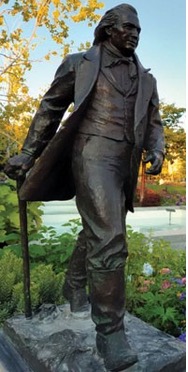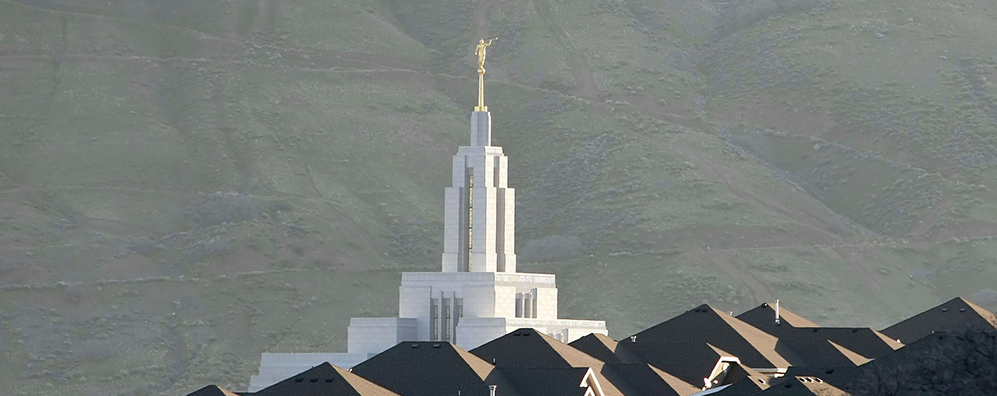For Catholics, two questions frequently come up in talking about the Mormon faith. Is it a Christian religion? And is Mormon baptism valid? Interestingly, those two questions are closely related and have been a concern to Church leaders over the last decade because of the controversial Mormon practice of baptizing the dead.
Who Was Joseph Smith?

Statue of Joseph Smith Jr. on Temple Square in Salt Lake City. Shutterstock photo
The founder of Mormonism, Joseph Smith, was born in Vermont in 1805 and was living in New York when, in 1820, God the Father and Jesus Christ supposedly appeared to him and declared that he had been chosen to restore God’s kingdom on earth. Three years later, he claimed to have been visited by an angel named Moroni who revealed the existence of the authentic Gospel that had been taught by the Risen Christ to a lost branch of Israel residing in the Americas prior to the discovery of the New World by Columbus. He received this ancient record in 1827 on a set of golden plates, and the result of the translation was the Book of Mormon, published three years later at Palmyra, N.Y. Smith began preaching his new religion in western New York and northern Pennsylvania and soon after organized the Church of Jesus Christ of Latter-day Saints (today, often referred to as LDS) at Fayette, N.Y.
Smith and his followers found, not surprisingly, resistance to their new creed, and they were expelled from state after state. In June 1844, Smith was killed with his brother Hyrum by a mob in a jail in Carthage, Ill.
The remaining Mormons, led by Brigham Young, pushed westward and ultimately settled in Utah. In fact, one of the first encounters between Catholics and Mormons occurred in the fall of 1846, when the famed Jesuit missionary Pierre De Smet met the migrating Mormons near Council Bluffs, Mo. They asked many questions about his travels across the West and were much impressed with his description of the Great Salt Lake. Father De Smet did not claim that they chose Salt Lake to be their headquarters because of him, but choose it they did. They founded Salt Lake City and established themselves as a theocracy. Poor relations with the U.S. government over such issues as polygamy and the theocratic government climaxed in the Utah Mormon War (1857-1858), which ended with the arrival of a non-Mormon governor and the resignation of Young as head of both church and state. Utah entered the Union in 1896. Polygamy was finally abolished in 1890, with further prohibitions issued over the next years. Today, there are some 14 million members around the world, with Mormon missionaries sent out to many different countries.
Three Gods into One
In 2001, the Vatican’s Congregation for the Doctrine of the Faith (CDF) responded to a question about whether Mormon baptisms should be considered valid by Catholics. The answer was in the negative (see sidebar). And one of the main reasons for this conclusion was that LDS theology is polytheistic.
At first look, the baptismal formula used by Mormons appears Trinitarian: “Being commissioned by Jesus Christ, I baptize you in the name of the Father, and of the Son, and of the Holy Spirit.” However, as the CDF determined, this is not a true invocation of the Trinity, because the Father, the Son and the Holy Spirit in the teachings of the Latter-day Saints “are not the three persons in which subsists the one Godhead, but three gods who form one divinity. One is different from the other, even though they exist in perfect harmony” (L’Osservatore Romano, Weekly Edition in English, Aug. 1, 2001, Page 4).
As the CDF further pointed out, God the Father was once a mortal man from another planet who, through a series of progressions, achieved divinity. He and his wife, the heavenly mother, share the responsibility of creation and have sons in the spiritual world. Their firstborn son, Jesus Christ, equal to men, “has acquired his divinity in a pre-mortal existence. Even the Holy Spirit is the son of heavenly parents. The Son and the Holy Spirit were procreated after the beginning of the creation of the world known to us.”
The Celestial Kingdom
There are numerous other points of divergence between LDS and Catholic beliefs.
Mormons accept the idea of celestial marriage, a form of marriage that “seals” the husband and wife and their children together through eternity. The afterlife consists of a complex set of destinations for spirits, a Celestial Kingdom for the faithful and a spirit prison for sinners. The Celestial Kingdom is a three-tiered heaven: the highest heaven is for those believers sealed by celestial marriage; the second is for those who lived honorably but not heroically in their testimony of Christ; and the third is for unrepentant sinners. Even the sinners, however, will eventually be saved through the atonement of Christ, and sinners in the spirit prison and the lower levels of heaven may advance through accepting Mormon baptism. Missionary work also continues among those in spirit prison, which is why the Mormons famously baptize the dead by proxy.
These teachings, of course, are subject to some changes over time as the LDS believe in ongoing public revelation through the current leadership of the church, a notion entirely contrary to the Church’s clear teaching that public revelation ended with the death of the last apostle (see Catechism of the Catholic Church, Nos. 66, 73), although private revelations can still be given which in no way change or correct the Faith.
Common Ground
Despite these differences, there is much cultural ground that Catholics find with the members of the LDS. Mormons are supportive of a strong family life and are noted for their opposition to abortion and gay marriage. These make for considerable points of commonality, and we should be mindful always to treat our Mormon sisters and brothers with charity and justice. As the CDF noted in its assessment of Mormon baptism: “Catholics and Mormons often find themselves working together on a range of problems regarding the common good of the entire human race. It can be hoped therefore that through further studies, dialogue and good will, there can be progress in reciprocal understanding and mutual respect.”
The Question of Mormon Baptism
LDS teaching denies both that baptism was instituted by Christ and the existence of original sin. Mormons perform baptism only for those have reached the age of reason and are at least 8 years old. Notably, they claim that infant baptism was one of the ways that the Church sank into apostasy in the first centuries and that Catholic baptisms are invalid.
In 2001, the Vatican’s Congregation for the Doctrine of the Faith responded to questions about the validity of Mormon baptisms in the negative. The response cited several problems with Mormon baptism:
The form: Because of the severe problems in the doctrine of the Trinity, the form was judged invalid.
The intention of the celebrating minister: Owing to the problems with the form and Mormon beliefs regarding baptism and original sin, the minister of the LDS cannot do what the Catholic Church does in conferring baptism.
The Mormon church also practices baptism for the dead, the belief that those who have died as non-Mormons can become Mormons in the afterlife through baptism by proxy. This is one reason why Mormons are so active in genealogy and also why in 2008 the Congregation for Clergy urged bishops around the world to refuse the Mormon genealogical society access to the parish registers as there is the risk that deceased Catholics might be “re-baptized.” This has also been condemned by other faiths, such as Jewish leaders who consider it dis-respectful to the dead, especially victims of the Holocaust.

